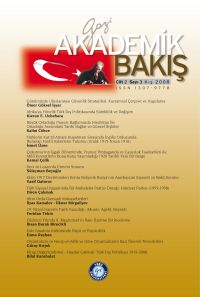

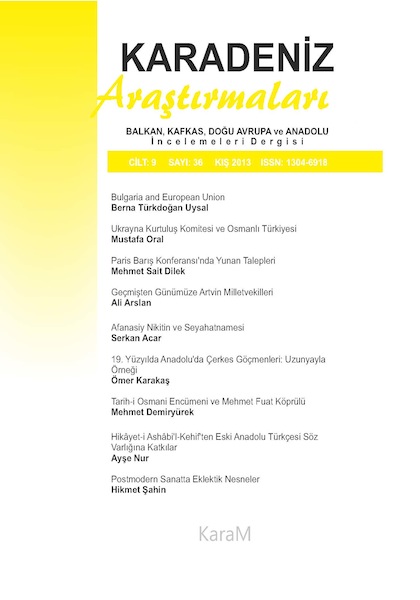
Keywords: lingua franca; Turkic languages; Caucasus; Azeri Turkic; Kumyk Turkic; multilingualism
The Caucasus is a region, where many languages belonging to various linguistic families are spoken. The linguistic diversity of the Caucasus is so substantial that in the past it had been called as the “Mountain of Tongues” There has been the need for lingua francas in the Caucasus like every region, where people speaking various languages co-existed. It is seen that Turkic languages have fulfilled this need in the Caucasus as the region had been ruled by various Turkic peoples for centuries. It is observed that particularly Azeri and Kumyk Turkic have established their selves the region with a wide diffusion area. The influence of these two languages in the Caucasus has been so strong that even Russian has not been able to obliterate this influence despite all efforts of the rulers.
More...Keywords: Pre Turkish Civilization; Turkey; Turkish Language;
The Proto-Turkish civilization has a great importance for all Turks living in Eurasia both culturally and politically. Specially for Turks living in Turkey for thousands of years. The Proto-Turkish civilization in Anatolia is a prove that Turks moving in waves from Central Asia to Analia for thousands of years. Proto-Türkish civilization is also the fundamental of the Turks or Turkic nations of Central Asia, from Azerbaican, Türkmenistan, Kazahistan, Uzbekistan, Kırgızitan, Tacikistan and Eastern Turkestan. Anatolia has been Turk’s country for thousands of years. Malazgirt victory in the year 1071 has been the last invasion wave of the Turks to Anatolia, but not the first wave as it is written by the Western Christian historiographers and also by westernised writers of “Tanzimat”.
More...Keywords: Central Asian Turkish Republics; Eurasian Geography; Turkish World;
With this list common Turkish cultural values are evaluated and several simple and practical advices to realise immediate cultural support is presented. In order to establish the Turkish cultural policy in Eurasia, Turkey must negotiate with other Turkish states and - so called Turkish-speaking States- to take further steps for this issue. Turkish culture, art and traditions are dating to ancient times. For cultural, commercial and political cooperation between Turkish states we may notify the Turkish Republic and governers of Turkish States of Central Asia for unity between these states.
More...Kırım Tatalarının 1987 yılında Moskova’da yaptığı gösteri Tataristan’da büyük bir heyecan uyandırdı. Bu heyecan Tataristan’daki milliyetçilik hareketlerini körükledi. Bu milli hareket çok kısa bir zaman içinde büyüdü ve 30 Ağustos 1990 tarihinde Tataristan cumhuriyeti bağımsızlığını ilan etti. Bağımsızlığı ilan ettikten sonra Tatar Milli Hareketi aydınlarının bir kısmı var olan milli ideolojinin halkın ihtiyaclarına tam olarak cevap vermediğini gördü. Bu aydınların “Türk Tatar Halkının Stratejik Yolu” adını verdiği bu ideoloji, 1997 yılında ilk şeklini aldı.
More...Türk milliyetçiliği, Türk ırkının şuuraltında binlerce yıldır yaşayan, soyunu üstün kılma ve yüceltme ülküsüdür. Dünya üzerinde hiçbir ülküde rastlanmayacak hatta diğer ülkü ve ülkelerce çılgınlık olarak nitelendirilecek cesarette atılımlara nail olabilmiş, Türk ruhunun manevi gıdası olmuştur. Türk milliyetçiliği'nin adını tam anlamıyla koymak icap ederse bunun ismi şüphesiz ki Türkçülük' tür. Türkçülük Tarihte farklı olaylardan ve akımlardan gücünü alarak kendini yenileyebilme vasfına sahip bir fikirdir. Türk’ün her devirde farklı hasımlarla mücadeleye girdiği muhakkaktır. Bu devirlerde Türkçülük de kendi bünyesinde özüne sadık kalmak şartıyla kendini yenilemiş, yeni kahramanlar çıkarmış, bu sayede varlığını bu güne kadar sürdürmüştür.
More...Günümüzdeki Türk lehçelerinin birleştirilmesi için üç örneklem seçtik. Kırgız, Saka Türkçeleri ve Türkiye Türkçesi. Söylenişteki ayrımları alfabede birleştirme yoluna giderek dezavantajı avantaj haline getirebiliriz. Çalışmamızda bunun için Y- J, C, Ç, S harflerinin söylenişteki farklılıklarını avantaja dönüştürmek için Ý önerisini sunuyoruz. Böylece gelecek nesiller birbiri ile mesafe uzakta olsa yazışırken daha büyük bir kolaylık yakalayacaktır.
More...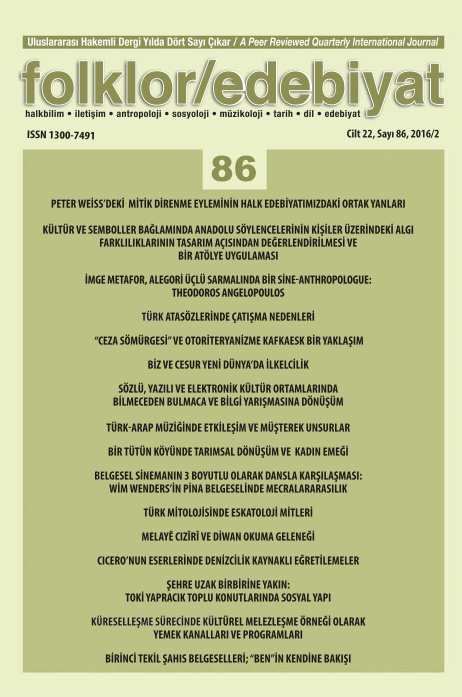
Keywords: conflict; national culture; proverb; power culture; collective culture;
The main objective of this study is to analyze the causes of conflicts in Turkish culture through Turkish proverbs. In this regard classic proverb study has been done in this study. At the end of the study, it was first reached the conclusion that conflict in Turkish culture is perceived as a natural process. Such that; conflict is considered necessary for creative thinking production and problem solving. Once again, in Turkish culture it was seen the situations that create problems are believed clearly obvious. It was found the dominant perception that when precautions are not taken, especially small and unimportant conflicts will lead to bigger problems. 7 general causes of conflicts have been found in Turkish proverbs. They can be named as social sensitivity issues, distributional justice, interpersonal relationships, personality, communication, reactions to previous conflicts and power balance. Each causes of conflict heading have been discussed in the light of literature. First of all, in Turkish culture, it was found that inattention to social sensibility about religious, moral, family values was perceived as basic reason of conflicts. Also, injustice in sharing resources is another reason that causes conflicts. On the other hand, interpersonal relations are emerging as general title among conflict reasons; plenty of situations like negligence in relationships, power imbalances, end of common interests are discussed under this heading. Furthermore, it was underlined that personality traits like disbelief, aggression, intenseness; opposite personality traits of each other or similar personality traits of each other in the negative meaning in relation are especially seen as reason of conflict. In addition, people’s mode of communication, the language used and third parties misleads are refers to another conflict reason major title as communication. It has been found that the cultural properties of Turkish proverbs about conflicts consistent with the characteristics of being power distant and collective culture like the results of Turkey’s national culture studies. In this study it has been also focused on the causes of conflicts in relation to advice given by the Turkish proverbs. Finally, in some cases the criticism have been carried out as causes of conflicts in the Turkish proverbs.
More...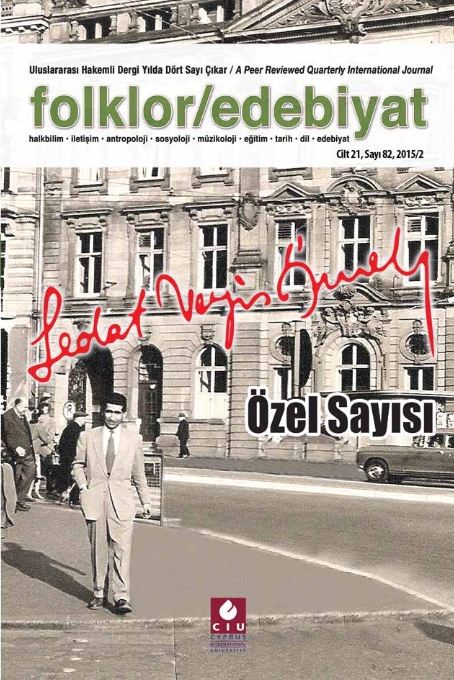
Bilindiği gibi folklor terimi ilkin 1846 yılında W. J. Thomas tarafından İngiltere’de ortaya atılmıştır. Sözcüğün kökeni folk(=halk) ve lore(=bilim)’den gelmektedir; anlamı da halkbilimi demektir. Anglo-Sakson ülkeleriyle Fransa’da “Folklore”, Alman dili konuşan ülkelerde de “Volkskunde” adını alan bu bilim dalı uzun süreden beri Batı üniversitelerinde ders olarak okutulmaktadır. Dilimize de folklor olarak geçen bu terim, bir zamanlar, Türkçe karşılığı olan “Halkbilgisi” ve “Halkbilimi” biçiminde kullanılmış, fakat sonraları “Folklor” olarak yaygınlık kazanmıştır.
More...
Halkbilimi (folklor), kimimize sözcük olarak yabancı ama aslında hepimizin, hergün içinde yaşadığı bir bilim dalı Sevgili Okurlar! Bazı konuları görürüz, yaşarız ama nedir, nasıl oluşmuştur, bilemeyiz. İşte bunlardan biri de halkbilimidir. Düğünümüzden derneğimize, acılı günlerimizden eğlencelerimize değin, tüm törenlerimiz bir “Halkbilimi” konusu değil de nedir? İlgi duyacağınıza inandığımız bu konu için, kısa bir süre önce Kültür Yayınlarımız arasında yayınlanan “Türk Halkbilimi” adlı yapıtın yazarı Sayın Prof. Dr. Sedat Veyis Örnek’le konuştuk… Bankamız Kültür Yayınları arasında yayımlanan “Türk Halkbilimi” adlı bir yapıtınız var. Önce bize “Halkbilim ya da “Folklor” un bilimsel açıdan ne olduğunu kısaca özetler misiniz?
More...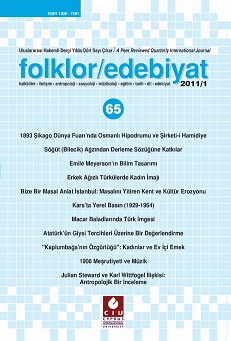
Keywords: Oral poetry; ballad; folk song; Turks’ image; Turkish-Hungarian relations;
Throughout the history, Hungarians having relations with Turks as their common geography settled Volga region the Kuban River from Eurasian plains had entered under the domination of the Caspian, at the end of the 9th century they immigrated to today’s homes. Besides Budin invasion by the Turks in 1686 and Hungary’s was brought under control, the fact that 150-year siege to take place has left several features will forever impact in the Hungarian culture and language. Within the context of Turkish-Hungarian cultural interaction the data showing the effects of Turkish in the Hungarian culture, in addition to traditions and vocabulary, the narrations such as legends, folk tales in oral literature involve. However, until today, in the frame of Turkish-Hungarian relations among these oral narrations shows the relations between two nations, what is unknown genre -especially in Türkiye- in oral literature is the ballad. In European culture, one of the genres in oral literature and oral music which is one of the basic types of ballad, a story told with music that often anonymous and unique musical narrative is a kind of radical. This limited study, compiled by the Hungarian oral culture is described in a sample group of ballads, old style that characterized the nature of the motion is attributed to the type of Turk, the image of Turk will be tried to portray. The basic data used and reviewed examples of the Hungarian ballad, is based on Hungarian Ballads and the European Ballad Tradition with his two-volume immortal work by Lajos Vargyas, the most comprehensive research on Hungarian folk ballads and the study of Ildikó Kriza (1980) Hungarian Folk Ballads and Nepdalok es Balladak Egyal-Dunai Szekely Közössegböl by Ujvary Zoltan (1968) who researched on the various aspects of Turk figures in Hungarian folk theater. In addition, another study of Lajos Vargyas (2005) Europa Diakkönyvtar/ Magyar Nepballadak.
More...Keywords: Turkish World; Turkish World Union; Turkish World Citizenship; Perception;
The aim of this research is to reveal the perceptions of Turks about Turkish World and Turkish World Union living in independent Turkish states, Turkish societies living as minority and self-governed Turkish societies. For this purpose, descriptive scanning model was used in the research. The research group is composed of 415 academicians selected with Criterion Sampling and Convenience Sampling which are among the purposive sampling methods. “Turkish World Perception Questionnaire” including 20 open and closed-ended questions developed by the researchers in order to measure the perceptions of the participants about Turkish World Union was used as data collection. The questionnaire prepared in “Google Forms” was sent to the participants via e-mail. The obtained data were analyzed by descriptive statistical analysis methods via SPSS 20 package program and frequency and percentages were calculated. As a result of the research it has seen that the participants perceived Turkish World concept as “the root of common Turkish civilization”; Turkish World citizenship concept as “consciousness of being able to act in the common denominator based on the sameness and similarities of the Turkish World individuals”. They also think that these two concepts that they feel close to, must be implemented for practical purposes. Although the majority of the participants proud of Turkish world, they indicated historical and cultural elements as the source of this pride. In conclusion, it has been seen that the people in the Turkish World have similar perceptions and they think that the establishment of the Turkish Union is necessary, important and useful.
More...
Keywords: Turkish art; Representation; Symbol;
In this research, the relationship between representation of Turkish art and representation is examined in terms of the main factors, general trends, styles and different expression forms that guide Turkish art. Representation from the early periods of Turkish art until the 18th century is a symbolic and iconographic character. The westernization politics of the Ottomans and the process of modernization have formed an illusionary, analogical representation of the similarity in art. Taking a stand against the imitation of the Turkish modern art of the Republic era, he advocates the view that art does not depend only on the external reality of the model. By using different artistic disciplines of contemporary Turkish art, a pluralistic, interactive production orientation ceases to exist in terms of the similarity between image, object, work and meaning; it is understood that the work is connected to the social consensus in the indicator series. Therefore, studies in contemporary Turkish art can be included in formal representation and new naturalistic representation.
More...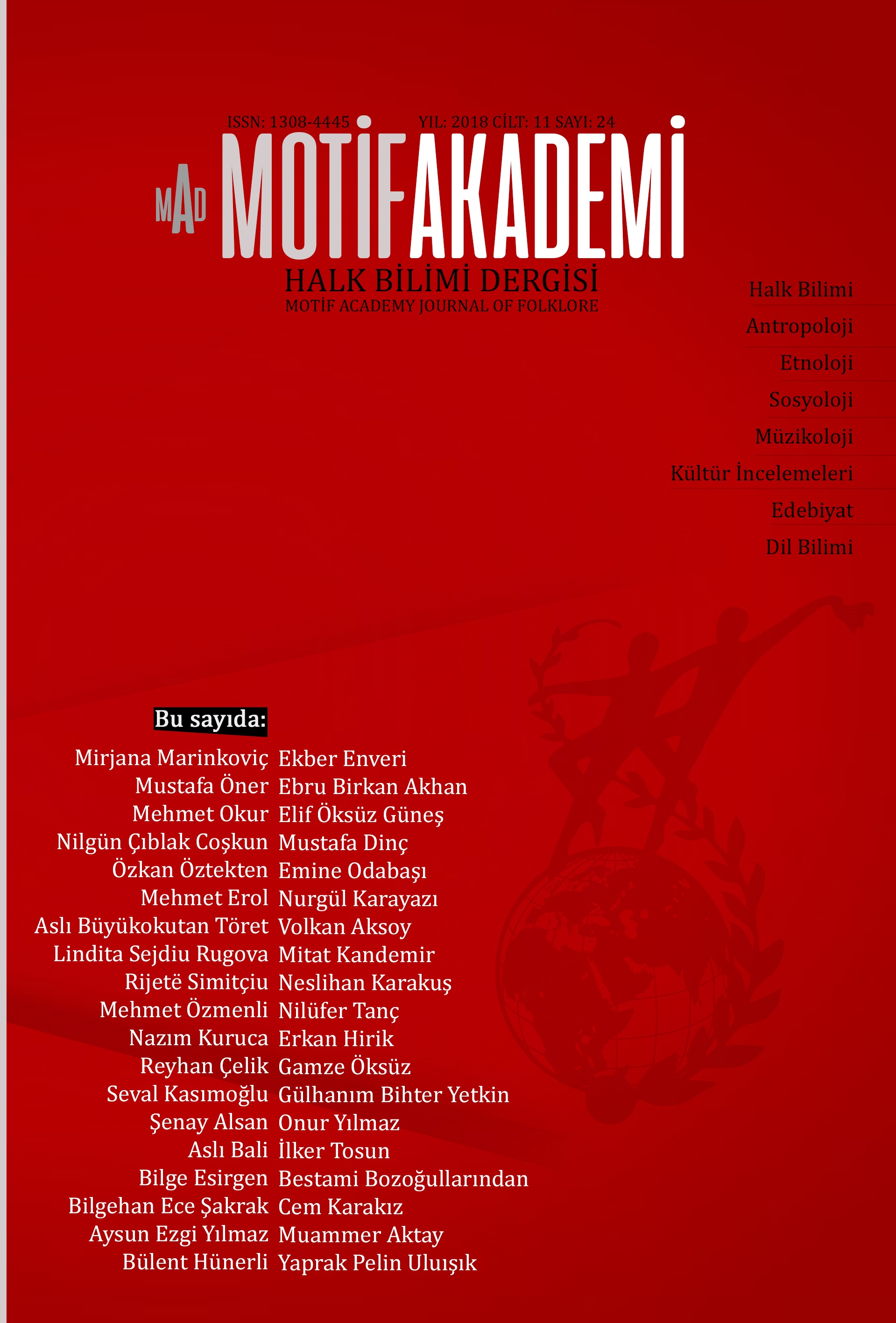
Keywords: Human;Turk; myth; creation; soil;
In creation myths traditionally, the primitive-human can be said to be what material was created from it in a particular society. But universally, it is understood that man perceives everything as a starting point for the soil, which sees itself and all living beings as the main food source. That is why in many myths, human are reported to have been created from the soil. In the myths of Turkish creation, the situation is slightly different. As it is known, in the previous periods before the Turks came to the stage of history, the myths of creation from trees are seen. However, in later periods, especially the changes of the Turkish tribes in the way of the (Inner Asia) Steppe and therefore the way of life, must be reflected in their myths. In short, I do not think it will be enough alone to explain the myths of creation from the soil in the myths of Turkish creation only through the contacts with heavenly religions.
More...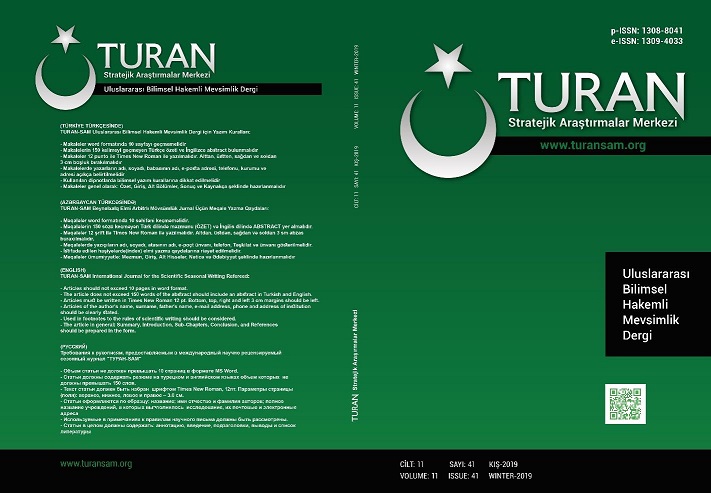
Keywords: Nevruz; Turkish World; traditions; celebrations; spring festival;
Nevruz is the traditional spring festival celebrated throughout the Turkish World. On March 21st, day and night are equalized and a new day begins. Nevruz means a new day, a new beginning and a new year and is celebrated with enthusiasm that day. Nevruzun is a great way of life in terms of unity, solidarity and peace. It is known that Nevruz Feast celebrated thousands of years between the Turks and other peoples with great fun and enthusiasm as the beginning of the new year and the arrival of spring. Especially this feast continues to be celebrated among the Turkish tribes since the departure from Ergenekon, that is to say the descent to the plain from the mountain, as the symbol of freedom, spring and life. "Nevruz is known as the day among the people, the darkness of the light, the coldness of the warmth, the truth of the day, the day when the good is evil, Nevruz is renovated and celebrated for life Nevruz is celebrated with local colors and beliefs in a vast region from Turkestan to the peoples of the Balkans, it is a day celebrating the arrival of spring. There is a deeply rooted and rich history in the regions of Nevruz Bayramı where Anatolia and Turkish culture spread. With the 21st of March, the air starts to warm up, the snow melt, the trees bloom, the soil blooms, and the migratory birds return to their homes. For this reason, March 21st is regarded as the day of awakening, resurrection and creation for all beings. As it is seen in the twelve Animal Turkic calendar, it has been known for a long time in the Turks and is celebrated with ceremonies. The main narration about Nevruz in Turks is to be accepted as a day of salvation today. So get out of Ergenekon. For this reason today Nevruz in the Turks was accepted as the beginning of the new year and celebrated with the feast day by day. Azerbaijan, Kazak, Kyrgyz, Turkmen, Uzbek, Tatar, Uyghur Turks, Anatolian Turks and Balkan Turks from Turkic societies have kept the Nevruz tradition alive until today.
More...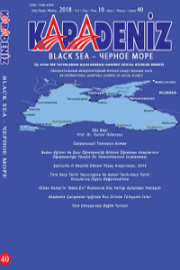
Keywords: Türkish world; health; tourism; health tourism; termal tourism; spawellness;
Health tourism has become an important tourism kind in respect to revenue and the number of participant. It is supposed that it will go on developing increasingly within the next years. Health tourism has actualised for three different purposes. The first of them is Medical tourism, the second one is thermal spring and spa-wellness, and the third one is the tourism of elderly care and disabled care. The leading countries in health tourism are India, Singapore,Malaysia, South Africa and Turkey respectively. Turkey is on the fifth rank in World Health Tourism. More than three hundreds patience acceptance have been taken place to Turkey by year of 2013. Patiences usually from Germany, Holland, Austria, Iraq and Belgium utilize a service related to generally eye, tooth, orthopedics and plastic surgery fileds. The vital leading destinations are Antalya and Istanbul in Turkey.
More...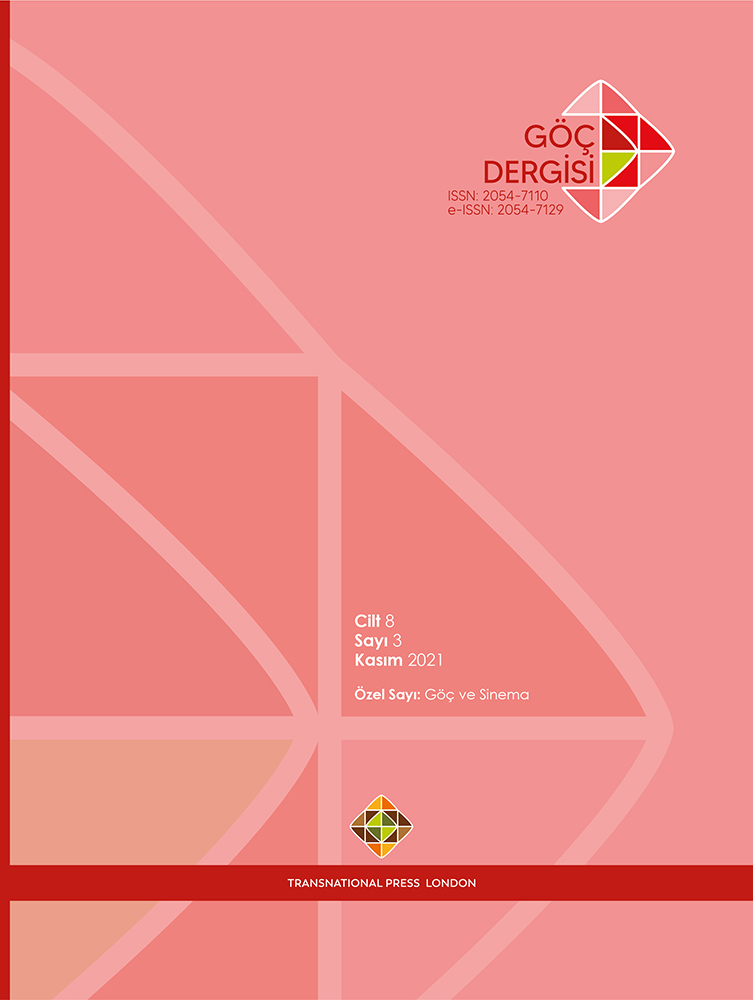
Keywords: Transnational Turkish Cinema; Immigrant Films; Migration; Cinema and Immigration; Accented Cinema;
Transnational Turkish Cinema emerged together with other branches of art as a result of Turkish workers who went to work temporarily to Europe and then settled there. Although Transnational Turkish Cinema was an immigration cinema in the beginning, in time, it has changed its language and content proportionally to the developments experienced by the workers there. Transnational Turkish Cinema, which is based on the inability to adapt to the country they are in and the problems it brings, in a way, has filled the gap in the field that Yeşilçam did not or could not do at the beginning. Transnational cinema, which developed with the films made by the second and third generation immigrants, the children of the first to go, has now gained a different perspective with the films made by today's representatives. In this study, the changes that Transnational Turkish Cinema, which was formed within the framework of international worker migration, has undergone since its beginning years were examined. In the beginning and development stages of the study, Transnational Turkish Cinema was defined through the problems experienced by Turkish workers who went to work in European countries since the 1960s, and the films produced within the framework of harmony. Comparative analyzes of the films of the second and third generation directors born and raised in the country of immigration and the previous period were evaluated through the representation of the characters in the stories and the change in the narrative. Transnational Turkish Cinema also has a sociological importance as it mirrors the change over time of the immigrant class living in the country where the films are made. In the study, it was also tried to analyze this change through films.
More...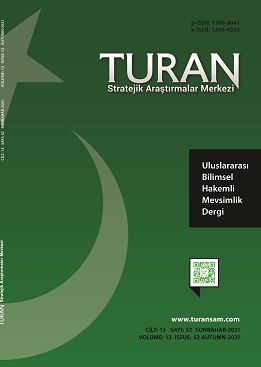
Keywords: Onion; cuisine; Turkish cuisine;
The origin, which is used as a basic ingredient in main dishes in Turkish cuisine, goes back to 3000 BC. Onions are widely grown in almost every region of the world. Onion in Turkish cuisine; It is also consumed with salads, meat dishes, stuffed meats, pastries or alone It is also widely used in world cuisines. Out of the kitchen, .It is protective against heart disease and cancer outside the kitchen It has positive effects on human psychology. In addition, onion, which has a high economic value due to its widespread use, has a special importance in exports. In this study, the use of onion in Turkish cuisine was examined.
More...
Keywords: Tajikistan; Great Powers; politics;
Review of: Fahri TÜRK, Büyük Güçlerin Kıskacındaki Ülke Tacikistan, Nobel, Ankara, 2022, ISBN: 978-625-433-387-3
More...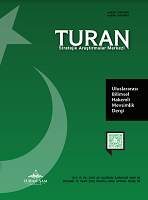
Keywords: Halva; Turkish; culinary culture;
In Turkish cuisine, halva has a very important place in terms of nutrition. Since the past, halva is the indispensable dessert of all times from birth to death. While halva, which has settled in our culture from the Middle East countries, is used to be fed in rural areas, it has become a celebration dessert in the palace kitchens. The separation of a separate section for halva making in the palace kitchens reveals the importance given to halva. Due to the beliefs of the nomadic Turks, the belief that well-cooked food will make the souls of the dead happy, caused them to cook halva widely. In addition to these, halva has been the main dessert of meetings in Turkish society. In our country, halva has different names according to the regions. As the regions differed, the materials used changed. The nutritional value of halva can be increased by differentiating the materials used. In this conceptual study, the document review method was chosen to collect data. As a result of the study, it has been revealed that halva has been cooked as a dessert and widely consumed from past to present and it is very important in Turkish culinary culture.
More...